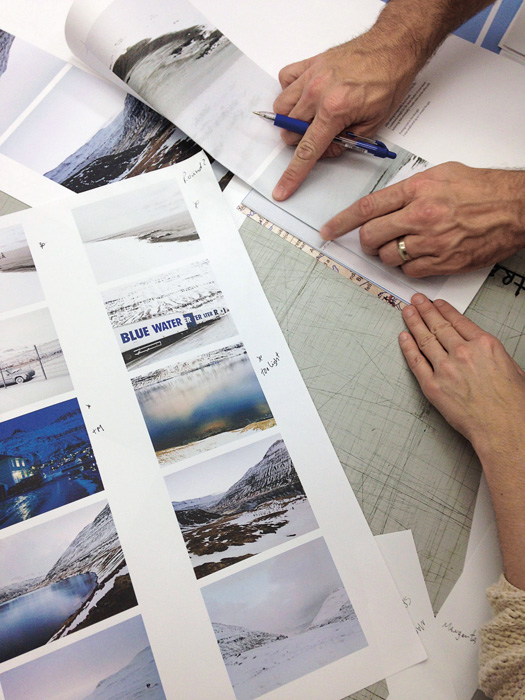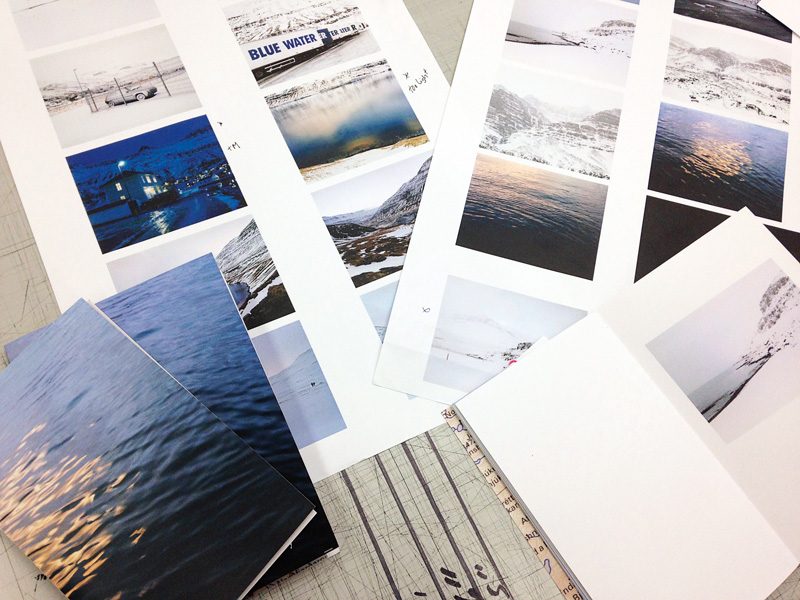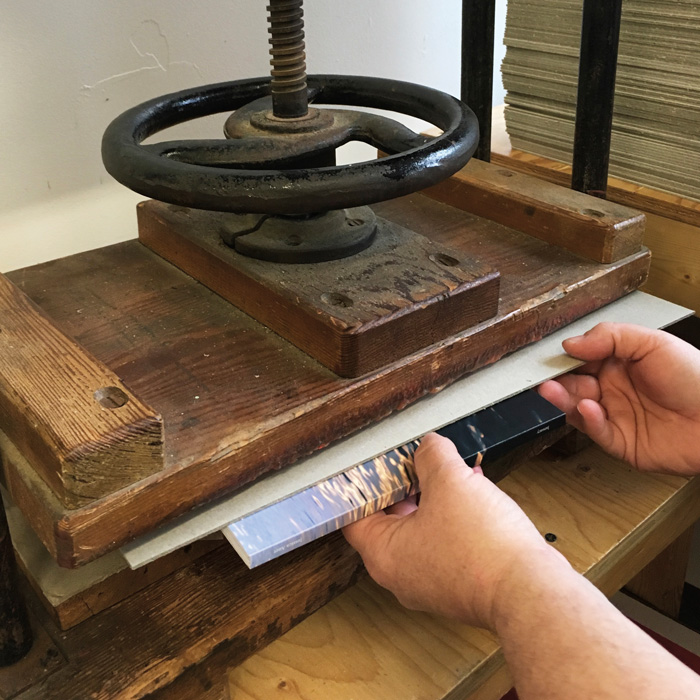First, there was a fox. A few strollers noticed him, but he evaded a closer look by disappearing into the weeds of a post-industrial lot in Montreal East. I quickly took a liking to the animal and made him a sort of personal totem. A discreet presence in the urban environment, this light-footed nonconformist seemed little inclined to raise his voice to claim his originality. When, in 2012, I had the idea of founding a publishing house, the fox seemed to represent my ambitions perfectly: to produce books that, without opposing the Quebec publishing ecosystem, would discreetly weave their way in, with the goal of reaching a small group of photobook lovers, and, by doing so, to question how these books are made in Quebec.
By Louis Perreault
My colleagues Alexis Desgagnés1 and Mona Hakim2 have already, in the pages of Ciel variable, discussed the shortfalls in support for both production and publicizing of artist books in Quebec, which means that this type of publication lags well behind its international counterparts. In spring 2017, artist Serge Clément and I wrote a letter to the Conseil des arts et des lettres du Québec (CALQ) to ask for changes to the eligibility criteria for the Promotion program, which provides grants to visual artists. We proposed that it would be desirable to broaden the criteria to respond to artists’ desire to produce something other than monographs, the only real publication form recognized by the program. The letter was co-signed by more than forty colleagues and friends, and it received a polite response from CALQ management, promising a review of the programs that would take our concerns into consideration. If I had to identify the main motivation for my commitment to being an artist and a publisher, independence would certainly be very high on the list. In fact, as much as one might ignore the foxes prowling the neighbourhoods of the city, they will always be a part of it, given their synanthropic nature. Like foxes, independent publishing initiatives will continue to multiply, and one day a way will have to be found to provide them with support analogous to that for initiatives that correspond to programs’ current standards.
I founded Les Éditions du renard3 in September 2012, when I had two series of images that I wanted to publish as photographic fanzines. Each series was accompanied by a description of its production, and I believed that placing them page by page would infuse the work with a sense of narrative. A strong interest for photobooks was already perceptible for some years and I was keeping track of what was going on elsewhere. So, I published two short staple-bound books, with a print run of fifty copies each, in half-letter-size format.
A few publications later, the books of Les Éditions du renard gradually began to find their public and became known for their minimalist style and pocket format. Although I took responsibility for these aesthetic choices, few realized that they were dictated mainly by rather rudimentary budgetary conditions. Rarely do we speak of the relationship that exists between the works that we look at and the technological and budgetary limitations that have permitted or constrained production. As artists, though, we know how important these limitations are when we consider how to materialize of our projects.
Today, rulers, Exacto knives, and white glue continue to be my valuable allies, and the studio floor is still the receptacle for the early sequences of laser-printed pages. Each detail of material fabrication of a book, sooner or later, has manifested its significance and forced the making of decisions. Partnerships with high-quality printers and a bookbinder who knows all the secrets of this fascinating trade4 piqued my growing curiosity about the possibilities available to the artist. Beyond being a simple vehicle for content that could exist in other forms, the book has become an integral component of the artworks contained on its pages.
Le Capteur, by Bertrand Carrière, published in late 2015, opened a door through which I could glimpse what awaited Les Éditions du renard in the event that the community offered me its trust by purchasing my books and producing its own with my company. For instance, Kate Hutchinson’s The Park and Alexis Desgagnés’s Banqueroute preceded a book of my own, Laurier Palace. Bertrand’s visual journal and Kate’s portraits, the close relationship between Alexis’s photographs and his poetry, and the fragmented nature of the memory that I was trying to evoke – all seemed naturally destined for the book form, on both the conceptual and the narrative levels.
Although, until fall 2016, I worked alone in developing my business, it seemed necessary, at this point in the story, to find an ally to run the publishing house with me. My friend Jean-François Hamelin, also a photographer, co-instigator of the Photobook Club de Montréal,5 and who shared my vision of the photobook, was a natural choice. Collaboration was a fundamental aspect of my publishing process, and it would now be an integral part of decision making and reflection about how things would continue.
So, that’s the chronology of things. Readers who are learning for the first time of the existence of Les Éditions du renard may wonder why I am describing this adventure. Contemplating beforehand the task that awaited me before beginning to write this essay, I could sense the main trap I had to avoid – that of getting bogged down in the personal details of my approach and getting too comfortable with the false impression of having well and truly initiated something original. Actually, it was by watching other artists take risks, putting “doing” in the foreground of their practice – even to the point of exposing themselves to failure – that I found the motivation to commit myself similarly. I saw in a couple of Swedish publishers in residence at Centre VU in Quebec City6 an example to follow in terms of artistic self-determination; I admired a certain American photographer’s creative approach to an entrepreneurial project;7 I was interested to discover what was happening among our American neighbours;8 I began to worship an English publisher that recently began to put out fascinating, sometimes cryptic, but always intriguing books.9 Therefore, I am taking the liberty of looking back at my career as a publisher more so that readers can see the reflection of what my peers abroad were doing. I believe that the desire to produce books more simply, added to the possibilities offered by the development of digital technologies, has enabled artists to take charge of their publication projects. Today, the results can be found everywhere, in the form of photobooks of exceptional material quality, dazzling fanzines, and atypical publications emerging from the experimentation that is part of DIY culture.
And yet, this passion is still quite timid in Quebec.10 It is difficult to define exactly why this is so, but I suspect that a certain way of doing things and of consuming art books has something to do with it. Whereas initiatives similar to Les Éditions du renard are legion in Europe, Asia, and the United States, the tendency of granting agencies to consider a publication above all from the point of view of the promotion of its author’s career seems to have taken hold in this province. In addition, a lack of real institutional interest in this form of expression,11 a limited public composed mainly of initiates that is broadening only slowly, and lack of coverage by the written press make the photobook a seriously underdeveloped field in Quebec.
For artists who do not intend to take up self-publishing, there are mainly two ways to get a book published. First, they may approach “regular” – commercial, traditional – publishing houses, most of which have realized that art books don’t pay very well. (I think about the fact that I started in books soon after Les 400 coups, which had published monographs for a number of years, abandoned the idea of doing so.) Second, they may approach artist-run centres and submit to a process that sometimes seems akin to throwing a bottle into the ocean and having it turn up only once one has lost all hope of seeing it again, or the initial throwing of which has become a distant, foggy memory. In this situation, what should artists do? Wait until one or another publisher gives a favourable response? Of course, a retrospective of a body of work might take months, or even a few years, to make it through the publication procedure. For a book that is being incorporated into the creation of a project or one in which content production takes place over a limited time, however, these models do not respond well to the very nature of the process in play.
In these cases, self-production becomes, for all practical purposes, necessary. But not just anyone can become a publisher. Not only does producing a book require some technical knowledge but many marketing questions must quickly be answered. From the desire to meet these challenges arise structures such as Les Éditions du renard. They develop naturally through partnerships and affinities, a little like artist-run centres do. It is my opinion, though, that a small leadership nucleus is essential: it preserves the spirit of freedom and spontaneity that is so stimulating in the creation of such a structure, and it avoids the kind of cumbersome bureaucracy that is inevitable when an organization expands.
Unfortunately, every good thing comes with its drawbacks, and the relatively private experience of beginnings may remain private quite a long time, if there is no support from others. I continue to believe that it is good for an industry to be composed of players the success of which must be measured on very different scales; and I also believe that coexistence of these different scales is healthy for the publishing industry as a whole. Yet, one fundamental – and potentially fatal – problem facing small publishing houses is lack of access to distribution networks, which are too expensive in a context in which the cost to produce books is often exorbitant. Financing publishing, it must be said, absorbs the majority of revenues from sales, most of which are shared by the distributor and the bookstore (between 60 and 70 percent of the sale price of a book) and, consequently, cannot be used to pay for production. Assistance with distribution would therefore be helpful for publishers that do not qualify for production and operating grants. The smaller players would get recognition by reaching a readership that is otherwise inaccessible.
Finally, small publishers like Les Éditions du renard have much to gain from the involvement of established institutions. It would be wonderful if a biennale such as MOMENTA, which resonates beyond the borders of Quebec and Canada, were to include – as its international counterparts do – a book fair, and a photobook award chosen by a jury of experts, and give a voice to commentators, critics, popularizers, and practitioners from the world of publishing. This would make it possible, incidentally, to recognize the photobook as an essential manifestation of contemporary photography and would facilitate contacts between its local and international players. Although the trend is to extend the photographic field to the boundaries of the “image,” photographs continue to have a place of honour when printed in the pages of books.
. . .
Just a note, in conclusion, to give you the latest news about my fox. He has been spotted many times in the Hochelaga-Maisonneuve neighbourhood of Montreal, and some may even have seen him on the Internet following his adventures in the Saputo Stadium, where he took refuge for a while. I would bet that they tried to trap him to return him to his “natural environment,” but I will tell you a secret: he is not about to disappear. I saw a few of his pups running freely in the fields last week. Foxes are well and truly among us, and we will have to accommodate their presence.
Translated by Käthe Roth
2 See Mona Hakim, “Le livre photographique : un état des lieux,” Ciel Variable 106 : 92–93.
3 Which would translate as Fox Publishing.
4 Laura Shevchenko at The Bookbinder’s Daughter.
5 The Photobook Club de Montréal was an initiative of Thomas Bouquin, Jean-François Hamelin, and Josée Shryer.
6 Thobias Fäldt and Klara Källström from B-B-B Books.
7 Alec Soth, with Little Brown Mushroom.
8 J and L Books, Twin Palms Publisher, The Ice Plant, and others.
9 Michael Mack’s publishing house, MACK, started up in 2010.
10 It is important to note that I am speaking here only of what is being done in the field of photography. The Expozine fair for small publishers, in Montreal, clearly shows that independent publishing is bursting with creativity in the fields of graphic novels, poetry, and graphic arts in general.
11 Nevertheless, the excellent initiatives by the McCord Museum, which periodically organizes activities around photo books, should be pointed out.
Louis Perreault is a photographer, a professor at Cégep André-Laurendeau, and co-publisher at Les Éditions du renard.



